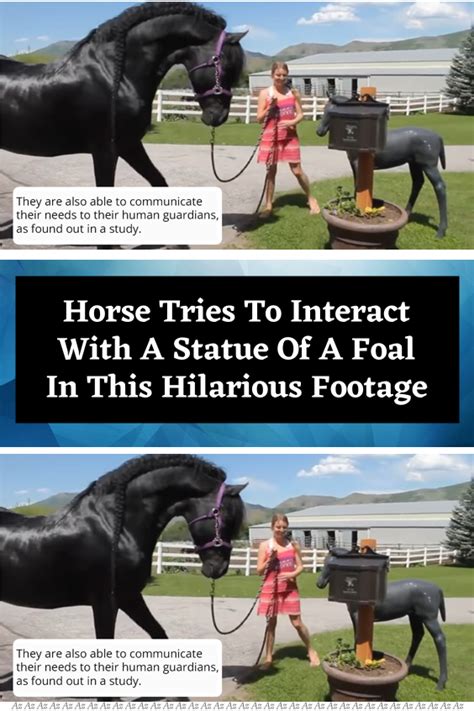
A frantic search for a supposedly missing foal in Shelby County, Kentucky, turned into a comical case of mistaken identity when a group of mares panicked over a foal that was, in fact, present and accounted for, sparking a social media frenzy and highlighting the strong maternal instincts within horse herds.
The incident, which unfolded on a horse farm, began when one mare seemingly lost track of her foal. Her distress quickly spread to other mares in the herd, triggering a widespread panic as they joined the search. “They were all worked up, running around, calling for their babies,” said a witness familiar with the events. The perceived crisis prompted concerned individuals to share the news online, leading many to believe a foal had genuinely gone missing. However, the situation was soon clarified when the foal was discovered to be safe and sound, merely separated from its mother briefly, while remaining within the herd’s proximity. The episode serves as a testament to the strong bonds within horse communities and the powerful maternal instincts that drive their behavior.
The initial alarm stemmed from the mares’ heightened sensitivity to the whereabouts of their offspring. Horses are known for their close-knit social structures, and the well-being of the young is a community concern. When one mare signals distress, others often respond in kind, leading to collective action. In this instance, the miscommunication amplified the response, resulting in a humorous, albeit initially concerning, scenario.
“It’s not uncommon for mares to get anxious if they can’t immediately locate their foals,” explains Dr. Emily Jenkins, an equine behaviorist. “Their natural instinct is to protect their young, and any perceived threat or separation can trigger a strong reaction.” This instinctive behavior is deeply rooted in the survival mechanisms of horses, where collective vigilance enhances the safety of the group and its vulnerable members.
The incident also underscores the role of social media in modern communication. While the rapid spread of information allowed for quick awareness, it also contributed to the initial confusion. The story quickly gained traction, illustrating how easily narratives can be amplified online, sometimes outpacing the verification of facts. Nevertheless, the episode ended on a lighthearted note, with many users expressing amusement and relief that the foal was safe.
The event offers insight into equine behavior, herd dynamics, and the intersection of animal instincts and human interaction. It serves as a reminder of the complex social lives of horses and the importance of understanding their natural behaviors to better manage and care for them. The “foal frenzy” in Shelby County may have been a momentary source of panic, but it ultimately provided a heartwarming glimpse into the powerful maternal bonds that exist within the animal kingdom.
To understand the situation more thoroughly, it’s crucial to delve into the biological and behavioral aspects of horses, their social structures, and the environmental factors that can influence their actions. This incident is not an isolated event; similar occurrences have been observed in various horse populations, highlighting the consistency of their innate behaviors.
Equine Social Structure and Maternal Bonds
Horses are social animals that live in herds, which provide protection from predators and facilitate resource sharing. A typical herd consists of a dominant stallion, several mares, and their offspring. The mares form strong bonds with their foals, which last for several months or even years. These bonds are essential for the foal’s survival, as the mare provides nourishment, protection, and guidance.
Maternal behavior in horses is complex and multifaceted. It begins during pregnancy, as the mare prepares for the arrival of her foal. After giving birth, the mare exhibits a range of behaviors aimed at ensuring the foal’s well-being. These behaviors include:
- Nursing: Mares nurse their foals several times a day, providing them with essential nutrients and antibodies.
- Grooming: Mares groom their foals to remove dirt and parasites, strengthening the bond between them.
- Protection: Mares protect their foals from predators and other threats, often displaying aggressive behavior if necessary.
- Teaching: Mares teach their foals essential survival skills, such as grazing, drinking, and avoiding danger.
The strength of the maternal bond can vary depending on the individual mare and the circumstances. However, in general, mares are highly protective and attentive to their foals, demonstrating a deep and enduring connection.
The Role of Communication in Herd Dynamics
Communication is vital for maintaining social cohesion within a horse herd. Horses communicate with each other through a variety of means, including:
- Vocalizations: Horses use a range of vocalizations, such as whinnies, neighs, and snorts, to communicate different messages.
- Body language: Horses use body language, such as posture, facial expressions, and tail movements, to convey their emotions and intentions.
- Scent: Horses use scent to identify each other and to mark their territory.
In the case of the “foal frenzy,” the mares likely communicated their distress through a combination of vocalizations and body language. The initial mare’s panic likely triggered a cascade of similar responses from the other mares, leading to the widespread alarm.
Environmental Factors and Behavioral Responses
Environmental factors can also influence horse behavior. Factors such as weather conditions, food availability, and the presence of predators can all affect how horses interact with each other and their environment.
In this instance, the open environment of the horse farm likely contributed to the mares’ anxiety. With more space for foals to potentially wander and less direct visibility, the mares’ heightened sensitivity to separation was amplified. The lack of immediate visual confirmation of the foal’s whereabouts escalated their concern, leading to the collective search.
Similar Incidents and Scientific Research
The “foal frenzy” incident is not unique. Similar occurrences have been observed in horse populations around the world. These incidents highlight the consistency of equine social behavior and the importance of understanding their natural instincts.
Scientific research has provided valuable insights into equine behavior and social dynamics. Studies have shown that:
- Mares are highly attuned to the needs of their foals.
- Herd dynamics play a crucial role in the well-being of horses.
- Environmental factors can significantly impact horse behavior.
By studying these factors, researchers can gain a better understanding of how to manage and care for horses in a way that promotes their physical and psychological well-being.
The Impact of Human Interaction
Human interaction can also influence horse behavior. Horses are highly sensitive animals, and they can be easily affected by human emotions and actions. It’s important for humans to interact with horses in a calm and respectful manner, as this can help to build trust and strengthen the bond between them.
In the case of the “foal frenzy,” the human response to the perceived crisis may have inadvertently amplified the situation. While the concern was well-intentioned, the sharing of information on social media without full verification contributed to the initial confusion. This underscores the importance of verifying information before sharing it online, especially when dealing with potentially sensitive situations involving animals.
Lessons Learned and Future Implications
The “foal frenzy” incident provides valuable lessons about equine behavior, herd dynamics, and the impact of human interaction. By understanding these factors, we can better manage and care for horses, ensuring their physical and psychological well-being.
Some key takeaways from this incident include:
- Horses are highly social animals with strong maternal instincts.
- Communication plays a vital role in maintaining social cohesion within a herd.
- Environmental factors can significantly impact horse behavior.
- Human interaction can influence horse behavior, both positively and negatively.
- It’s important to verify information before sharing it online, especially when dealing with potentially sensitive situations involving animals.
Moving forward, it’s essential to continue researching equine behavior and social dynamics. This will help us to develop more effective management practices that promote the well-being of horses and ensure their long-term survival.
The Role of Genetics and Breed Characteristics
While environmental and social factors play significant roles, genetic predispositions and breed characteristics can also influence maternal behavior in horses. Some breeds, known for their strong maternal instincts, may exhibit more pronounced reactions to foal separation or perceived threats. For instance, breeds developed for ranch work or those with a history of living in harsh environments might display heightened vigilance and protective behaviors.
Genetic research into equine behavior is ongoing, but preliminary studies suggest that certain genes may be associated with specific behavioral traits, including maternal care. Understanding these genetic factors can provide further insights into the variations in maternal behavior observed across different horse breeds.
The Importance of Early Socialization
Early socialization plays a crucial role in shaping a foal’s behavior and its future interactions within the herd. Foals that are exposed to a variety of stimuli and social interactions during their early months tend to be more well-adjusted and less prone to anxiety. Proper socialization helps foals develop confidence and learn how to navigate the social dynamics of the herd.
Conversely, foals that are isolated or deprived of social interaction may develop behavioral problems, such as excessive fearfulness or aggression. Therefore, providing foals with ample opportunities to interact with other horses and humans is essential for their overall well-being.
Nutrition and Maternal Health
A mare’s nutritional status and overall health can also influence her maternal behavior. Mares that are malnourished or suffering from health problems may be less attentive to their foals. Ensuring that mares receive proper nutrition and veterinary care is essential for supporting their maternal health and ensuring that they can adequately care for their offspring.
Research has shown that deficiencies in certain nutrients, such as selenium and vitamin E, can impair immune function and increase the risk of health problems in foals. Therefore, providing mares with a balanced diet that meets their specific nutritional needs is crucial for promoting the health and well-being of both the mare and her foal.
The Economics of Horse Farming and Welfare Considerations
The economics of horse farming can also indirectly affect equine welfare and management practices. In some cases, economic pressures may lead to compromises in animal welfare, such as overcrowding or inadequate veterinary care. However, responsible horse farmers recognize that the well-being of their animals is essential for their long-term productivity and profitability.
Sustainable horse farming practices prioritize animal welfare, environmental stewardship, and economic viability. These practices include providing horses with ample space to roam, access to fresh water and forage, and regular veterinary care. By adopting sustainable practices, horse farmers can ensure the health and well-being of their animals while also protecting the environment and promoting the long-term sustainability of their operations.
Advances in Equine Veterinary Medicine
Advances in equine veterinary medicine have significantly improved the health and well-being of horses. New diagnostic tools, treatments, and preventative measures have helped to reduce the incidence of disease and injury in horses.
For example, advancements in reproductive technology have made it possible to improve the fertility of mares and increase the success rate of artificial insemination. These advancements have had a significant impact on the horse breeding industry, allowing breeders to produce higher-quality foals and improve the genetic diversity of horse populations.
The Future of Equine Research and Management
The future of equine research and management is focused on improving our understanding of horse behavior, health, and welfare. Researchers are using a variety of tools and techniques, including genomics, proteomics, and behavioral analysis, to gain new insights into the complex lives of horses.
These insights will help us to develop more effective management practices that promote the well-being of horses and ensure their long-term survival. For example, researchers are working to develop new vaccines and treatments for equine diseases, as well as new strategies for managing horse populations in a sustainable manner.
The Role of Education and Outreach
Education and outreach play a crucial role in promoting responsible horse ownership and management. By educating horse owners and the general public about equine behavior, health, and welfare, we can help to ensure that horses are treated with respect and compassion.
Many organizations are dedicated to promoting equine education and outreach. These organizations offer a variety of programs and resources, including workshops, seminars, and online educational materials. By supporting these organizations, we can help to ensure that horses receive the care and attention they deserve.
The Shelby County “foal frenzy” incident, while humorous in retrospect, underscores the importance of continued research, education, and responsible management practices in ensuring the well-being of horses. By understanding their complex social behaviors and responding to their needs with informed care, we can foster a more harmonious relationship with these magnificent animals. The incident also serves as a reminder of the power of social media and the importance of verifying information before sharing it, especially when it involves the welfare of animals. The quick dissemination of information, while potentially helpful, can also lead to unnecessary panic and confusion. Responsible use of social media in such situations is crucial.
Frequently Asked Questions (FAQ)
1. What exactly happened in the “foal frenzy” incident?
A: In Shelby County, Kentucky, a mare appeared to have lost her foal, triggering a panic among other mares in the herd. They began searching and calling out, creating the impression that a foal was missing. However, the foal was later found to be safe and nearby, leading to a realization that it was a case of mistaken alarm and heightened maternal instincts.
2. Why did the other mares join in the search for the foal?
A: Horses are social animals with strong herd dynamics and maternal instincts. When one mare shows distress over a potentially missing foal, other mares, especially those with their own foals, often respond in kind. This collective response is a natural behavior aimed at protecting the group’s young and ensuring their safety.
3. Was the foal ever actually in danger?
A: No, the foal was never actually in danger. It was merely separated from its mother for a short period but remained within the vicinity of the herd. The situation was a result of the mares’ heightened sensitivity and concern for their offspring’s whereabouts.
4. What does this incident tell us about horse behavior?
A: The incident highlights several key aspects of horse behavior, including their strong social bonds, maternal instincts, and communication within the herd. It demonstrates how quickly alarm can spread among horses and how they collectively respond to perceived threats to their young. It also underscores the importance of understanding their natural behaviors to better manage and care for them.
5. What can horse owners learn from this event?
A: Horse owners can learn the importance of understanding herd dynamics and recognizing the signs of distress in mares. Being aware of these behaviors can help them respond appropriately to situations and prevent unnecessary panic. Additionally, the incident underscores the importance of verifying information before sharing it, especially on social media, to avoid causing unnecessary alarm.









